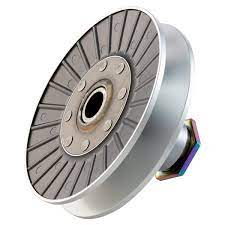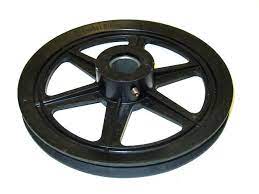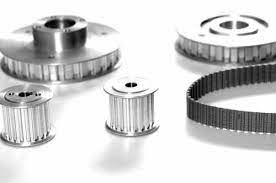Product Description
Conveyor Pulley is manufactured as per customer requirement,with main design under national standard,quality inspection focusing on shaft core,welded joint,rubber material and hardness,dynamic balance and so on for longer product life time.
| Drive/Head Pulley – A conveyor pulley used for the purpose of driving a conveyor belt. Typically mounted in external bearings and driven by an external drive source. |
| Return/Tail Pulley – A conveyor pulley used for the purpose of redirecting a conveyor belt back to the drive pulley. Tail pulleys can utilize internal bearings or can be mounted in external bearings and are typically located at the end of the conveyor bed. Tail pulleys commonly serve the purpose of a Take-Up pulley on conveyors of shorter lengths. |
| Snub Pulley – A conveyor pulley used to increase belt wrap around a drive pulley, typically for the purpose of improving traction. |
| Take-Up Pulley – A conveyor pulley used to remove slack and provide tension to a conveyor belt. Take-Up pulleys are more common to conveyors of longer lengths. |
| Bend Pulley – A conveyor pulley used to redirect the belt and provide belt tension where bends occur in the conveyor system. |
The specification of pulley:
Drive Drum: is the main component of power transmission. The drum can be divided into single drum (the angle of the belt to the drum is 210 ° ~ 230 °) , Double Drum (the angle of the belt to the drum is up to 350 °) and
multi-drum (used for high power) .
Bend Drum: is used for changing the running direction of the conveyor belt or increasing the surrounding angle of the conveyor belt on the driving roller, and the roller adopts a smooth rubber surface . The drum shaft shall be forgings and shall be nondestructive tested and the inspection report shall be provided.
The Various Surface of Pulley:
Conveyor pulley lagging is essential to improve conveyor belt performance, the combination of our pulley lagging can reduces belt slippage, improve tracking and extends life of belt, bearing & other components.
| PLAIN LAGGING:This style of finish is suitable for any pulley in the conveyor system where watershed is not necessary. It provides additional protection against belt wear, therefore, increasing the life of the pulley. |
| DIAMOND GROOVE LAGGING:This is the standard pattern on all Specdrum lagged conveyor pulleys. It is primarily used for reversing conveyor drive pulleys. It is also often used to allow bi-directional pulley rotation, and the pattern allows water to be dispersed away from the belt. |
| HERRINGBONE LAGGING:The herringbone pattern’s grooves are in the direction of rotation, and offers superior tractive properties. Each groove allows water and other liquids to escape between the face of the drum pulley and the belt. Herringbone grooved pulleys are directional and should be applied to the conveyor in a manner in which the grooves point toward the direction of the belt travel. |
| CHEVRON LAGGING:Some customers specify that the points of the groove should meet – as done in Chevron styled lagging. As before with the herringbone style, this would be used on drive drum pulleys and should be fitted in the correct manner, so as to allow proper use of the pattern and water dispersion also. |
| CERAMIC LAGGING:The Ceramic tiles are moulded into the lagging which is then cold bonded to the drum pulley. This style of finish allows excellent traction and reduces slippage, meaning that the belt tension is lower and, therefore as a result, increases the life of the pulley. |
| WELD-ON STRIP LAGGING: Weld-On Strip Lagging can be applied to bi-directional pulleys, and also has a finish to allow the easy dispersion of water or any fluids between the drum pulley and the belt. |
The Components of Pulley:
| 1. Drum or Shell:The drum is the portion of the pulley in direct contact with the belt. The shell is fabricated from either a rolled sheet of steel or from hollow steel tubing. |
| 2.Diaphragm Plates: The diaphragm or end plates of a pulley are circular discs which are fabricated from thick steel plate and which are welded into the shell at each end, to strengthen the drum.The end plates are bored in their centre to accommodate the pulley Shaft and the hubs for the pulley locking elements. |
| 3.Shaft :The shaft is designed to accommodate all the applied forces from the belt and / or the drive unit, with minimum deflection. The shaft is located and locked to the hubs of the end discs by means of a locking elements. The shaft and hence pulley shafts are often stepped. |
| 4.Locking Elements:These are high-precision manufactured items which are fitted over the shaft and into the pulley hubs. The locking elements attach the pulley firmly to the shaft via the end plates. |
| 5.Hubs:The hubs are fabricated and machined housings which are welded into the end plates. |
| 6.Lagging: It is sometimes necessary or desirable to improve the friction between the conveyor belt and the pulley in order to improve the torque that can be transmitted through a drive pulley. Improved traction over a pulley also assists with the training of the belt. In such cases pulley drum surfaces are `lagged` or covered in a rubberized material. |
| 7.Bearing: Bearings used for conveyor pulleys are generally spherical roller bearings, chosen for their radial and axial load supporting characteristics. The bearings are self-aligning relative to their raceways, which means that the bearings can be ‘misaligned’ relative to the shaft and plummer blocks, to a certain degree. In practical terms this implies that the bending of the shaft under loaded conditions as well as minor misalignment of the pulley support structure, can be accommodated by the bearing. |
The Production Process of Pulley:
Our Products:
| 1.Different types of Laggings can meet all kinds of complex engineering requirements. |
| 2.Advanced welding technology ensures the connection strength between Shell and End-Disk. |
| 3.High-strength Locking Elements can satisfy torque and bending requirements. |
| 4.T-shape End-Discs provide highest performance and reliability. |
| 5.The standardized Bearing Assembly makes it more convenient for the end user to replace it. |
| 6.Excellent raw material and advanced processing technology enable the shaft can withstand enough torque. |
| 7.Low maintenance for continued operation and low total cost of ownership. |
| 8.Scientific design process incorporating Finite Element Analysis. |
Our Workshop:
/* January 22, 2571 19:08:37 */!function(){function s(e,r){var a,o={};try{e&&e.split(“,”).forEach(function(e,t){e&&(a=e.match(/(.*?):(.*)$/))&&1
| Material: | Carbon Steel |
|---|---|
| Surface Treatment: | Baking Paint |
| Motor Type: | Frequency Control Motor |
| Samples: |
US$ 40/Piece
1 Piece(Min.Order) | Order Sample Free sample
|
|---|
| Customization: |
Available
| Customized Request |
|---|
.shipping-cost-tm .tm-status-off{background: none;padding:0;color: #1470cc}
|
Shipping Cost:
Estimated freight per unit. |
about shipping cost and estimated delivery time. |
|---|
| Payment Method: |
|
|---|---|
|
Initial Payment Full Payment |
| Currency: | US$ |
|---|
| Return&refunds: | You can apply for a refund up to 30 days after receipt of the products. |
|---|
What are some real-world examples of drive pulley applications in various industries?
Drive pulleys find extensive applications in various industries where power transmission and control are essential. They play a critical role in numerous systems that involve the movement of materials, products, or people. Here are some real-world examples of drive pulley applications in different industries:
1. Manufacturing and Industrial:
- Conveyor Systems: Drive pulleys are widely used in manufacturing and industrial settings to power conveyor systems that transport materials or products within factories, warehouses, and distribution centers. These systems are employed in industries such as automotive, food processing, logistics, and packaging.
- Machinery: Drive pulleys are utilized in various types of machinery, including milling machines, lathes, drill presses, and woodworking equipment. They enable the transmission of power to drive the rotational motion of cutting tools or workpieces, allowing for precise machining and fabrication processes.
- Textile Industry: Drive pulleys are found in textile machinery, such as spinning machines and looms, where they provide power transmission to move fibers, yarns, and fabrics through different stages of the manufacturing process.
2. Mining and Quarrying:
- Belt Conveyors: Drive pulleys are extensively used in mining and quarrying operations to power belt conveyors that transport bulk materials, such as coal, ores, aggregates, and minerals. These conveyors are crucial for efficient material handling and are commonly employed in mining sites, quarries, and material processing plants.
- Crushers and Screens: Drive pulleys are utilized in crushers and screens to transmit power and control the movement of materials during the crushing and screening processes in mining and quarrying operations. They enable the efficient processing and sorting of various types of minerals and aggregates.
3. Construction and Infrastructure:
- Concrete Plants: Drive pulleys are used in concrete mixing plants and concrete batching plants to power conveyor belts that transport aggregates, cement, and other materials required for concrete production.
- Escalators and Moving Walkways: Drive pulleys are crucial components in escalators and moving walkways, providing the power and control necessary for the continuous movement of steps or walkway surfaces. These systems are commonly seen in shopping malls, airports, train stations, and other public spaces.
- Cranes and Hoists: Drive pulleys are employed in cranes and hoists to transmit power and control the lifting and lowering of heavy loads in construction sites, warehouses, and shipping ports.
4. Automotive and Transportation:
- Engine Systems: Drive pulleys are used in automotive engines as part of the accessory drive system to transmit power from the engine crankshaft to components such as the alternator, power steering pump, water pump, and air conditioning compressor.
- Power Steering Systems: Drive pulleys are employed in power steering systems to transfer power from the engine to the power steering pump, enabling assisted steering in vehicles.
- Heavy-Duty Trucks and Buses: Drive pulleys are utilized in heavy-duty trucks and buses to transmit power from the engine to various accessories and systems, such as the air compressor, hydraulic pump, and cooling fan.
These examples illustrate the diverse range of industries and applications where drive pulleys are integral components. From manufacturing and mining to construction and automotive sectors, drive pulleys are essential for efficient power transmission, material handling, and control in numerous real-world scenarios.
What safety considerations should be kept in mind when using drive pulleys?
When using drive pulleys, it is essential to prioritize safety to prevent accidents, injuries, and equipment damage. Here are important safety considerations to keep in mind:
1. Guarding and Enclosure:
Drive pulleys should be properly guarded and enclosed to prevent accidental contact with moving parts. Guards and enclosures should be designed and installed in accordance with applicable safety regulations and standards. They should effectively restrict access to the pulley and associated belts or chains, reducing the risk of entanglement or entrapment. Regular inspection and maintenance of guards and enclosures are necessary to ensure their effectiveness and integrity.
2. Lockout/Tagout Procedures:
When performing maintenance, repair, or servicing tasks involving drive pulleys, proper lockout/tagout procedures must be followed. Lockout/tagout procedures involve isolating the power source, locking out the energy supply, and using tags to communicate the equipment’s inoperable status. This ensures that the drive pulley and associated machinery cannot be accidentally started or operated while maintenance work is being conducted, protecting personnel from unexpected hazards.
3. Training and Education:
Personnel involved in operating, maintaining, or working near drive pulleys should receive proper training and education on safe practices. They should be familiar with the potential hazards associated with drive pulleys and understand the safe operating procedures, including the use of personal protective equipment (PPE), lockout/tagout protocols, and emergency response measures. Ongoing training programs should be implemented to keep personnel updated on safety best practices.
4. Risk Assessment and Hazard Identification:
A comprehensive risk assessment should be conducted to identify potential hazards and risks associated with the operation and maintenance of drive pulleys. This assessment should consider factors such as pinch points, entanglement hazards, electrical hazards, and potential for material spillage or falling objects. By identifying these risks, appropriate control measures can be implemented to mitigate the hazards and ensure a safe working environment.
5. Maintenance and Inspection:
Regular maintenance and inspection of drive pulleys are crucial for safety. Routine inspections should be performed to check for signs of wear, damage, or misalignment. Any issues identified should be promptly addressed, and damaged or worn components should be replaced. Lubrication requirements should be followed to maintain smooth operation and prevent overheating. Adequate records of maintenance and inspections should be maintained for reference and compliance purposes.
6. Ergonomics and Body Mechanics:
When working with drive pulleys, proper ergonomics and body mechanics should be observed to minimize the risk of strain or musculoskeletal injuries. Personnel should be trained in proper lifting techniques, avoiding excessive bending, lifting heavy loads, and maintaining good posture. Mechanical aids, such as hoists or lifting equipment, should be used when handling heavy pulleys or components to reduce the risk of injuries.
7. Warning Signs and Labels:
Appropriate warning signs and labels should be placed near drive pulleys to communicate potential hazards and provide safety instructions. These signs should be clearly visible and easy to understand. They may include warnings about rotating parts, entanglement hazards, pinch points, and required PPE. Warning signs and labels serve as visual reminders to personnel and visitors to exercise caution and follow safety protocols.
8. Emergency Stop and Emergency Response:
Drive pulley systems should be equipped with emergency stop controls that can quickly shut down the equipment in case of emergencies or hazardous situations. Personnel should be trained on the location and operation of emergency stop buttons. Additionally, an emergency response plan should be in place, outlining procedures for addressing accidents, injuries, or equipment malfunctions. This plan should include protocols for providing first aid, reporting incidents, and evacuating the area if necessary.
In summary, ensuring safety when using drive pulleys is of paramount importance. This involves proper guarding, lockout/tagout procedures, training personnel, conducting risk assessments, performing regular maintenance and inspections, observing ergonomics, using warning signs, and having emergency stop controls and response plans in place. By following these safety considerations, the risks associated with drive pulleys can be minimized, promoting a safe working environment.
In which industries and applications are drive pulleys commonly used?
Drive pulleys are widely used in various industries and applications where power transmission and motion control are essential. Their versatility and effectiveness make them a fundamental component in numerous mechanical systems. Here are some of the industries and applications where drive pulleys are commonly employed:
1. Manufacturing and Industrial Machinery:
Drive pulleys play a crucial role in manufacturing and industrial machinery. They are used in conveyor systems to transport materials or products along production lines. Drive pulleys enable the movement of items such as bulk goods, packages, and components in industries including automotive, food processing, mining, and logistics. Additionally, drive pulleys are found in various types of machinery, such as pumps, compressors, and generators, where they facilitate power transmission and rotational motion.
2. Agricultural Equipment:
In the agricultural sector, drive pulleys are employed in a range of equipment. They are used in farming machinery, including tractors, combines, and harvesters, to transmit power and control the operation of components such as belts, chains, and augers. Drive pulleys are vital in applications such as grain handling, irrigation systems, and equipment used for planting, harvesting, and processing crops.
3. Construction and Mining:
Drive pulleys are extensively utilized in the construction and mining industries. They are employed in heavy machinery, including cranes, excavators, loaders, and conveyor systems, to facilitate the movement of materials, such as soil, rocks, and ores. Drive pulleys are essential for the operation of equipment involved in earthmoving, material handling, and mineral extraction processes.
4. Material Handling and Warehousing:
In material handling and warehousing applications, drive pulleys are indispensable. They are used in conveyor systems to transport goods, packages, and materials within warehouses, distribution centers, airports, and shipping facilities. Drive pulleys enable the efficient movement of products along assembly lines, sorting systems, and storage areas, ensuring smooth and continuous workflow.
5. Automotive and Transportation:
Drive pulleys find widespread use in the automotive and transportation industries. They are employed in vehicles, including cars, trucks, buses, and trains, to transmit power from engines to various components such as water pumps, alternators, and air conditioning compressors. Drive pulleys also play a role in belt-driven systems, such as power steering and supercharging systems, enhancing vehicle performance.
6. Renewable Energy:
In the field of renewable energy, drive pulleys are utilized in wind turbines and solar tracking systems. Drive pulleys help convert wind or solar energy into rotational motion, driving generators or tracking mechanisms to maximize energy capture. They are critical components that enable efficient power generation in wind farms and solar power plants.
7. Exercise and Fitness Equipment:
Drive pulleys are commonly found in exercise and fitness equipment, such as treadmills, stationary bikes, and weight machines. They facilitate the transfer of power and motion from motors or users to various components, such as belts, flywheels, and resistance systems. Drive pulleys ensure smooth and controlled movement, allowing users to engage in effective workouts.
8. Marine and Shipbuilding:
In the marine industry and shipbuilding sector, drive pulleys are utilized in propulsion systems, winches, cranes, and cargo handling equipment. They play a vital role in transmitting power and controlling the movement of various components, enabling the operation of vessels, offshore platforms, and port facilities.
These are just a few examples of the industries and applications where drive pulleys are commonly used. Their versatility and importance in power transmission and motion control make them indispensable components in a wide range of mechanical systems across different sectors.
editor by CX
2024-04-13




